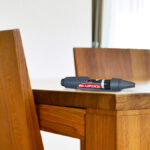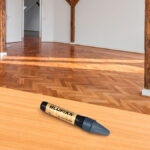PLASTIC BONDING
Plastic is not only extremely malleable, but also very stable. It can be used in a variety of ways. The disadvantage: plastic objects are very difficult to glue if they break.
The reason: many conventional adhesives adhere very poorly or not at all to smooth surfaces. In the worst case, they can even damage the plastic. But don’t worry: BLUFIXX SMART REPAIR for plastic and wood is a suitable adhesive for bonding all kinds of plastics effectively and permanently. It is specially adapted to different types of plastic.
Challenges when bonding plastic
Bonding plastic requires a great deal of precision and the right material. This is because plastic has a variety of surfaces and properties.
Typical problems when bonding plastic:
- Difficulty in achieving a strong and lasting bond
- Different types of plastic that require special adhesives
Different types of plastic
There are a large number of different types of plastic. A recycling symbol can be found on every plastic item.
This symbol can be used to distinguish between the different types. The symbol consists of three arrows. Most of them are green and arranged in a circle. These arrows symbolize the recycling cycle.
There is a number in the center of the circle of arrows. This number identifies the material used. There is usually also an abbreviation next to the symbol. This stands for the appropriate material group.
Here is an example:
If you see a recycling symbol with a “6” and the abbreviation “PS”, this is polystyrene. This material is usually hard and crystal clear. It is used in shopping bags, plastic bowls and disposable tableware.
However, most people know polystyrene in its foamed form as Styrofoam. It is a very popular material for packaging and insulating objects.
However, there is also harder plastic that meets higher requirements. This material is even used in medicine and for bulletproof vests. But that’s not all: hard plastic is also found in many objects in our households.
Fachbegriff: The so-called “thermoplastics” include, for example, polystyrene (PS), polypropylene (PP), polyethylene (PE), polycarbonate (PC), polyvinyl chloride (PVC), polyamides (PA) and acrylonitrile butadiene styrene (ABS).
Note:
Not all plastics are the same.
Which adhesive for plastic? – Bonding plastics
Bonding plastic with what? If you want to glue hard or soft plastic, you should use suitable adhesives such as special plastic adhesives. Most plastic adhesives are so-called contact adhesives.
After the plastic parts have been evenly and thinly coated on both sides with the special adhesive, they must first be left open. Otherwise the solvent cannot evaporate and the plastic will not stick together.
BLUFIXX SMART REPAIR for plastic, wood: The ideal solution
BLUFIXX SMART REPAIR is not just any old glue. The innovative repair kit has been specially developed for difficult materials such as plastic. It is the strongest adhesive for plastics and can be used for all types of plastic.
Properties of BLUFIXX:
- Easy to use
- Strong bonding power for an extremely strong hold
- Versatility for different types of plastic
- Suitable for plastic bonding: waterproof and transparent
Technical term: “Bonding strength” refers to the ability of the adhesive to permanently bond two surfaces together.
Note:
BLUFIXX SMART REPAIR offers a strong and versatile solution for bonding different types of plastic.
Step-by-step instructions: Bonding plastic with BLUFIXX SMART REPAIR
Bonding plastic with BLUFIXX SMART REPAIR should be carried out with a certain amount of care. Only then can the precise process succeed.
This is how it works:
Step 1: Preparation of the plastic parts to be bonded
- Clean the broken areas thoroughly. Ideally with a special plastic cleaner.
- Make sure that the parts are dry and free of dust and grease.
Step 2: Using the BLUFIXX set
- Apply a thin layer of BLUFIXX gel to one of the fracture sites.
- Carefully join the parts together.
- Use the enclosed UV light to cure the gel.
Tips for an optimal result:
- Avoid air bubbles when applying the gel.
- Apply light pressure to the glued parts for a few seconds to ensure optimum bonding.
- Remove excess gel before curing.
Note:
Careful preparation and application are crucial for a successful repair with BLUFIXX SMART REPAIR. Take enough time for this.
Testimonials from our customers
Numerous customers have already successfully used BLUFIXX SMART REPAIR to repair their plastic items. And they are delighted with its effectiveness and user-friendliness. BLUFIXX SMART REPAIR is not only versatile, but also offers a quick and permanent solution for bonding plastic.
BLUFIXX SMART REPAIR compared to other adhesives
BLUFIXX SMART REPAIR scores particularly well in terms of durability, aesthetics and ease of use compared to conventional bonding methods for plastics.
Advantages of BLUFIXX SMART REPAIR:
- Simple and clean application
- Strong and lasting bond
- Aesthetically pleasing, transparent result
Note:
BLUFIXX outperforms conventional bonding methods for plastic in many respects. The use of BLUFIXX supports an environmentally friendly and sustainable approach to the repair of plastic. The service life of plastic objects is extended, reducing the need to buy new items.
Buy now and get started right away!
Bonding plastic is not only easy with BLUFIXX SMART REPAIR, but also very effective. Thanks to our innovative light-curing technology, you can repair your everyday objects in just a few seconds.
Whether glass, stone, metal, plastic or wood. Use BLUFIXX SMART REPAIR to fill cracks or damage or add missing parts on almost all surfaces and materials.
Discover now our Product variety and let us convince you of their effectiveness!
FAQ
Can BLUFIXX be used for all types of plastic?
BLUFIXX is suitable for various types of plastic.
Can BLUFIXX be used for bonding heavy plastic?
BLUFIXX is also suitable for bonding heavy plastic and other plastic repairs.
How long does it take for BLUFIXX to cure?
BLUFIXX hardens in a few seconds under the enclosed UV light.
Is the result of the repair with BLUFIXX waterproof?
BLUFIXX is waterproof and resistant to everyday influences.
Is BLUFIXX heat-resistant?
BLUFIXX is also heat-resistant after curing.
Get in touch with us
Contact us
Do you have any questions about BLUFIXX products or your order?
We will be happy to help you at the following e-mail address:
info(at)multipac.de
All fields in the contact form are mandatory.





